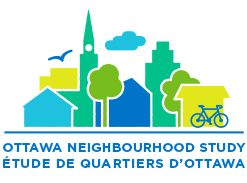About the Study
Goals
- To provide relevant, useful, and trustworthy information about Ottawa neighbourhoods that will support place-based planning and evaluation, program development, service delivery, advocacy, and community action.
- To advance and share evidence about how neighbourhood determinants of health contribute to health and promote well-being in Ottawa.
- To provide opportunities for dialogue about healthy neighbourhoods.
History
ONS is an interdisciplinary population health study administered by the University of Ottawa. Originally funded by the Canadian Institutes of Health Research (#79238) and titled “Tools to investigate the relationship between spatial disparities and their relationship to health disparities,” the study evolved into a pilot project with two primary objectives:
- To better define neighbourhoods in the city of Ottawa
- To measure and map the neighbourhood social determinants of health amenable to policy interventions.
Research
Contextual research is increasingly relevant in population health; there is growing evidence that neighbourhoods and communities have important impacts on our physical, mental, and social health. Multilevel studies have determined that residence in economically disadvantaged neighbourhoods is related to mortality, poor self-rated health, cardiovascular disease/risk factors, low birth weight, and child development issues. However, reviews of the international literature note shortcomings with many extant studies, including a lack of theory, a lack of precision when measuring context (most studies use limited and non-specific indicators such as area socio-economic status), the use of census tracts rather than natural neighbourhoods, and a lack of appropriate analyses.
The Ottawa Neighbourhood Study began with neighbourhood definition, done in an iterative fashion. The process to delineate “natural” neighbourhood units combines physical and functional approaches, comparisons with real estate maps, and a participatory research framework and is described more fully here:
The framework for the selection of social determinants of health was based on Abraham Maslow’s theory that people cannot grow and be physically, mentally and spiritually healthy until basic needs are satisfied. ONS considered this hierarchy of needs in the context of natural neighbourhoods, asking “What should a neighbourhood have to make it a good place to live, to be healthy, to grow, and to raise a family?”
ONS selected a comprehensive set of indicators that provides a great deal of specificity to conceptualize, operationalize and measure relationships between defined health outcomes and neighbourhood exposures. ONS applied 2 criteria to select contextual indicators of the social determinants of health,:
- The indicator has to be established as important to health within the learned literature, and
- The indicator’s context, composition, configuration, quality or quantity has to be amenable to change by various levels of government, community agencies, citizens’ associations, etc.
To collect the spatial and attribute data required to derive an indicator, ONS integrates existing data sets, manually verifies data, and uses various field research methods and algorithmic approaches (machine learning and AI). For example, contextual and compositional indicators of social determinants of health have been obtained from the Canadian Census, DMTI Enhanced Points of Interest, the City of Ottawa, the National Capital Commission, and the Ottawa Real Estate Board and co-investigators from Ottawa Public Health assembled a set of health indicators. Contextual data from commercial sources is independently verified using web research, telephone calls, and visits to the area. All indicators are then grouped by natural neighbourhood and shared using the maps, neighbourhood profiles and data visualizations that can be found on this web site.
ONS findings on the socio-economic distribution of resources for health and our multilevel analyses are important to literature on place and health and point the way to interventions to improve community health and well-being within Canada and elsewhere. Our university/community partnership model, methodology, and findings have served as a stimulus for other municipalities and university researchers; epidemiologists in other administrations in Ontario are now doing similar work.
Funding & Resources
The Ottawa Neighbourhood Study has office space at the School of Psychology at the University of Ottawa; the research is led by Dr. Betsy Kristjansson (Psychology) and Dr. Mike Sawada (Geography) and supported by students. The University provides significant administrative support and in-kind contributions to ONS. Additional in-kind supports and services are provided by our community partners including representation and participation on the ONS Steering Committee which provides guidance and oversight to the study. ONS is a member of the Ottawa and Region Data Consortium administered by the Social Planning Council of Ottawa. ONS appreciates the funding partnership with Western Ottawa Community Resource Centre and the core funding received from United Way East Ontario. This is supplemented by research grants, foundation funding, and consulting contracts. ONS has received awards: United Way Centraide Ottawa Community Builder of the Year Award (2010), IBM Centennial Award (2011), CIHR Partnerships Award (2012) and was a finalist for the ITAC Ingenious Award (2013).
What’s Next for ONS
Our plans, priorities and aspirations for the next 5 years (2020-2025) are available for download.
